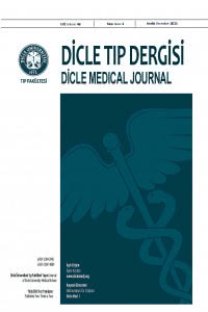Pyoderma gangrenosum in a patient with Crohn’s disease: Case report and a review of the literature
Crohn hastalığında piyoderma gangrenosum: Olgu sunumu ve literatürün gözden geçirilmesi
___
- 1. Brunsting LA, Goeckerman WH, O’Leary PA. Pyoderma (ecthyma) gangrenosum: clinical and experimental observations in five cases occurring in adults. Arch Dermatol Syph 1930;22: 655-80.
- 2. Schwaegerle SM, Bergfeld WF, Senitzer D, Tidrick RT. Pyoderma gangrenosum: a review. J Am Acad Dermatol 1988;18:559-68.
- 3. Perry HO. Pyoderma gangrenosum. South Med J 1969; 62:899-908.
- 4. Cairns BA, Herbst CA, Sartor BR, Briggaman RA, Koruda MJ. Peristomal pyoderma gangrenosum and inflammatory bowel disease. Arch Surg 1994; 129: 769-72.
- 5. Trost LB, McDonnell JK.Important cutaneous manifestations of inflammatory bowel disease. Postgrad Med J 2005;81:580-5.
- 6. Yüksel I, Başar O, Ataseven H,et al. Mucocutaneous manifestations in inflammatory bowel disease. Inflamm Bowel Dis 2009;15:546-50.
- 7. Schoetz D Jr, Coller JA, Veidenheimer MC. Pyoderma gangrenosum and Crohn’s disease: eight cases and a review of the literature. Dis Colon Rectum 1983;26:155-158.
- 8. Wollina U. Pyoderma gangrenosum--a review. Orphanet J Rare Dis 2007;2:19-26.
- 9. Aseni P, Di Sandro S, Mihaylov P, Lamperti L, De Carlis LG. Atypical presentation of pioderma gangrenosum complicating ulcerative colitis: rapid disappearance with methylprednisolone. World J Gastroenterol 2008;14:5471-3.
- 10. Cohen PR. Neutrophilic dermatoses: a review of current treatment options. Am J Clin Dermatol 2009;10:301-2.
- 11. Schöfer H, Baur S. Successful treatment of postoperative pyoderma gangrenosum with cyclosporin. J Eur Acad Dermatol Venereol 2002;16:148-51.
- 12. Kouklakis G, Moschos J, Leontiadis GI, et al. Infliximab for treatment of pyoderma gangrenosum associated with clinically inactive Crohn’s disease. A case report. Rom J Gastroenterol 2005;14:401-3.
- 13. Regueiro M, Valentine J, Plevy S, Fleisher MR, Lichtenstein GR. Infliximab for treatment of pyoderma gangrenosum associated with inflammatory bowel disease. Am J Gastroenterol. 2003;98:1821-6.
- 14. Miranda MF. Pyoderma gangrenosum treated with sulfasalazine and dapsone. Indian J Dermatol Venereol Leprol 2002;68:160-1.
- 15. Lynch WS, Bergfeld WF. Pyoderma gangrenosum responsive to minocycline hydrochloride. Cutis 1978; 21: 535-8.
- 16. Richardson JB, Callen JP. Pyoderma gangrenosum treated successfully with potassium iodide. J Am Acad Dermatol 1993; 28:1005-7.
- 17. Paolini O, Hebuterne X, Flory P, Charles F, Rampal P. Treatment of pyoderma gangrenosum with colchicine. Lancet 1995; 345: 1057-8.
- 18. Gupta AK, Shear NH, Sauder DN. Efficacy of human intravenous immune globulin in pyoderma gangrenosum. J Am Acad Dermatol. 1995; 32:140-2.
- 19. Kaminska R, Ikäheimo R, Hollmen A. Plasmapheresis and cyclophosphamide as successful treatments for pyoderma gangrenosum. Clin Exp Dermatol 1999;24:81-5.
- 20. Callen JP, Case JD, Sager D. Chlorambucil: an effective corticosteroid-sparing therapy for pyoderma gangrenosum. J Am Acad Dermatol 1989; 21:515-9.
- 21. Cave DR, Burakoff R. Pyoderma gangrenosum associated with ulcerative colitis: treatment with disodium cromoglycate. Am J Gastroenterol 1987;82:802-4.
- 22. Thomas CY Jr, Crouch JA, Guastello J. Hyperbaric oxygen therapy for pyoderma gangrenosum. Arch Dermatol 1974;110:445-6.
- ISSN: 1300-2945
- Yayın Aralığı: 4
- Başlangıç: 1963
- Yayıncı: Cahfer GÜLOĞLU
Crohn hastalığında piyoderma gangrenosum: Olgu sunumu ve literatürün gözden geçirilmesi
Oktay BULUR, Ayse Serap KARADAĞ, Yasar NAZLIGÜL, Servet GÜREŞCİ
Yutma güçlüğünün nadir bir nedeni: Anevrizmatik olmayan disfajia aortika
Zülfü ARIKANOĞLU, MURAT BAŞBUĞ, FATİH METEROĞLU, Celal YAVUZ
Bir üniversite hastanesinde yatan hastaların steroid kullanımına uyumunun değerlendirilmesi
MELEK SERPİL TALAS, Emine PINARCI
Karın duvarı endometriozisi: Olgu sunumu
Ali ÖZLER, Şadi YALDIZ, A. İhsan DEĞİRMENCİOĞLU
Farklı beslenme modellerinin hayatın ilk 12 ayındaki fiziksel büyüme üzerine etkileri
Emin ÖZKAYA, Soner SAZAK, AHMET GÜZELÇİÇEK, Nedim SAMANCI
Serebrovasküler infarktın nadir bir komplikasyonu: İki taraflı ses teli felci
Elif ÖNDER, Gökhan CELBEK, Adem GUNGOR, Talha DUMLU, Seher KIR, Yusuf AYDIN, Süleyman YILMAZ
Sendrom X fizyopatolojisinde uyku-apne sendromu\'nun rolü
Zuhal ARITÜRK, Abdurrahman ABAKAY, Ebru TEKBAŞ, Habib ÇİL, Gökhan KIRBAŞ, Sait ALAN, Mehmet YAZICI
Obez çocuklarda ambulatuar arteriyel kan basıncı izlem sonuçları
Nanotıp, mikrodizilimler ve klinik mikrobiyolojide kullanımları
Epidural blok sırasında gelişen dural yırtık sonrası anestezi yönetimi
